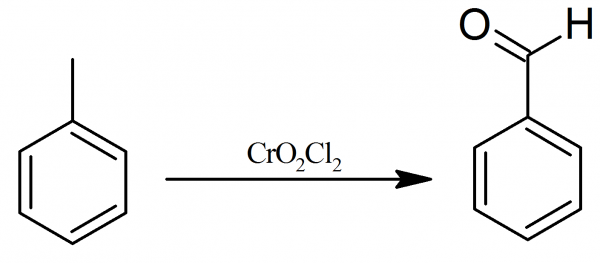
How will you convert Toluene to Benzaldehyde?
Answer
440.5k+ views
Hint: The conversion of Toluene to Benzaldehyde is used as a laboratory method in order to produce Benzaldehyde.
Complete step by step answer:
Chromyl chloride dissolved in
In case, the side-chain contains a group higher than

Benzaldehyde is also formed by oxidation of toluene with chromic oxide in acetic anhydride. Benzaldehyde reacts with acetic anhydride to form benzylidene diacetate which on hydrolysis with alkali or an acid yields benzaldehyde.
Additional Information:
(i) Benzaldehyde is a colourless oily liquid. Its boiling point is 452K.
(ii) It has the smell of bitter almonds.
(iii) It is sparingly soluble in water but highly soluble in organic solvents.
(iv) It is steam volatile.
(v) It is heavier than water
(vi) It is poisonous in nature.
Note: Benzaldehyde is an organic compound consisting of a benzene ring with a formyl (
Complete step by step answer:
Chromyl chloride dissolved in
In case, the side-chain contains a group higher than

Benzaldehyde is also formed by oxidation of toluene with chromic oxide in acetic anhydride. Benzaldehyde reacts with acetic anhydride to form benzylidene diacetate which on hydrolysis with alkali or an acid yields benzaldehyde.
Additional Information:
(i) Benzaldehyde is a colourless oily liquid. Its boiling point is 452K.
(ii) It has the smell of bitter almonds.
(iii) It is sparingly soluble in water but highly soluble in organic solvents.
(iv) It is steam volatile.
(v) It is heavier than water
(vi) It is poisonous in nature.
Note: Benzaldehyde is an organic compound consisting of a benzene ring with a formyl (
Recently Updated Pages
Master Class 10 Science: Engaging Questions & Answers for Success

Master Class 10 Social Science: Engaging Questions & Answers for Success

Master Class 10 Maths: Engaging Questions & Answers for Success

Master Class 10 English: Engaging Questions & Answers for Success

Class 10 Question and Answer - Your Ultimate Solutions Guide

Master Class 9 General Knowledge: Engaging Questions & Answers for Success

Trending doubts
Give 10 examples of unisexual and bisexual flowers

Draw a labelled sketch of the human eye class 12 physics CBSE

Differentiate between homogeneous and heterogeneous class 12 chemistry CBSE

Differentiate between insitu conservation and exsitu class 12 biology CBSE

What are the major means of transport Explain each class 12 social science CBSE

What is the difference between resemblance and sem class 12 social science CBSE




